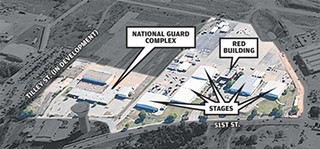The Changing Shape of Austin Studios
By Richard Whittaker, Fri., May 10, 2013
There's not much to see at the old National Guard Armory on East 51st Street.
A couple of unimposing office buildings, a shuttered helicopter hangar, and a long swath of empty parking lot. However, viewed from the Austin Film Society offices on the other side of a wire fence, the armory space is all potential. Since March, it has been the latest addition to Austin Studios, and now the challenge is how best to integrate it into AFS' long-term plans. AFS faces two key challenges: absorbing the armory and connecting the entire complex to the burgeoning Mueller development.
As the residential and commercial sections of Mueller expand, the studio flows and shifts around it. When the city gave the site to AFS in 2000, it was an isolated area of scrub and structures with no neighbors. AFS Executive Director Rebecca Campbell said, "It was dead silence the first day we got there." However, the lease came with a coda: As construction continued at Mueller, the studio and the city would swap parcels of land. As a result, what was the middle of the back lot 13 years ago is now the western edge. Every change has brought new opportunities and new problems. In 2008, the studio gave up a series of small aircraft or "tee" hangars, perfect for storage and small tenants, in return for an extra parking lot that served as an all-purpose back lot. The addition of the old armory complex is the final stage of the swap, and provides the first new structures since the tee hangars were demolished.
With this final exchange, the whole orientation of the studio could alter. At the moment, all entry is via East 51st, but the studio is considering opening up on the new Tilley Street, along the armory's eastern boundary. This could create more of a link to the community, while leaving 51st Street for tenants and productions. Unlike most studio managers, AFS faces a conundrum; as a film nonprofit, the staff wants to make the site accessible to the public, but at the same time, it still has to be a working studio with closed lots. Currently, the AFS offices and screening room are in a series of portable temporary cabins in the middle of the back lot – scarcely the ideal solution to their double duties. Campbell said, "All of that should be right there at the entrance, and that alone will make it easier to find us while giving greater privacy to productions on the lot."
For now, the wire fence between the studio and its latest addition stays up. On the armory side, the helicopter hangar is now temporary storage, and the only regular events are twice-weekly screenings by the Blue Starlite Mini Urban Drive-In (see "Nothing Mini About It," April 26). However, the studio plans to start new construction in 2014, paid for by a $5.4 million bond approved by voters last November. That cash will not go far – it will cover simple remediation and initial construction in the armory, plus the engineering and construction to link the two spaces into a single campus. The studio is technically part of the Mueller PUD (Planned Unit Development), Campbell said, "so when we do our construction, we're subject to the fairly stringent requirements that builders there have." That's the downside: The upside is that the studio can link itself into Mueller's big infrastructure, such as the gray water irrigation system, or future innovations like a fat-pipe Internet connection.
The bond projects are just phase one, as the studio is working on big plans. During December and January, AFS held a series of "Creative Placemaking" meetings with stakeholders about what exactly they want, not just from the armory but from the whole campus. The consensus was to balance the ability to attract big productions with the opportunity to create a broader creative hub. The armory will be the key. Early draft plans marked the helicopter hangar as stage seven, but if that plan does go ahead, it will most likely be aimed at servicing what are known as turnkey productions: one-day to one-week shoots, such as commercials and small indie projects, rather than features occupying the space for weeks or months.
The rest of the space looks likely to become a network of flexible offices, meeting spaces, and communal creative hubs, a model the studio has tested in the Red Building. The famous structure, visible from East 51st, was used as production management space until 2010, when True Grit was filmed at the studios. Since then, it has been leased out to a variety of small tenants, including casting agents, filmmakers, and producers. If the armory becomes flexible office space, the studio could once again offer the Red Building back to bigger productions. That extra flex space could serve as an incubator for new talent, as well as attract existing firms to become tenants. This could fulfill AFS' long-term goal to create a true one-stop production shop. Campbell said, "Having this new space that's a little more scalable should allow us to serve a wider section of the creative media community."
Got something to say on the subject? Send a letter to the editor.









